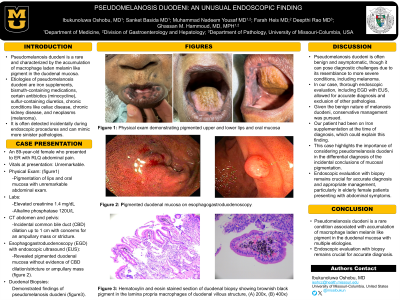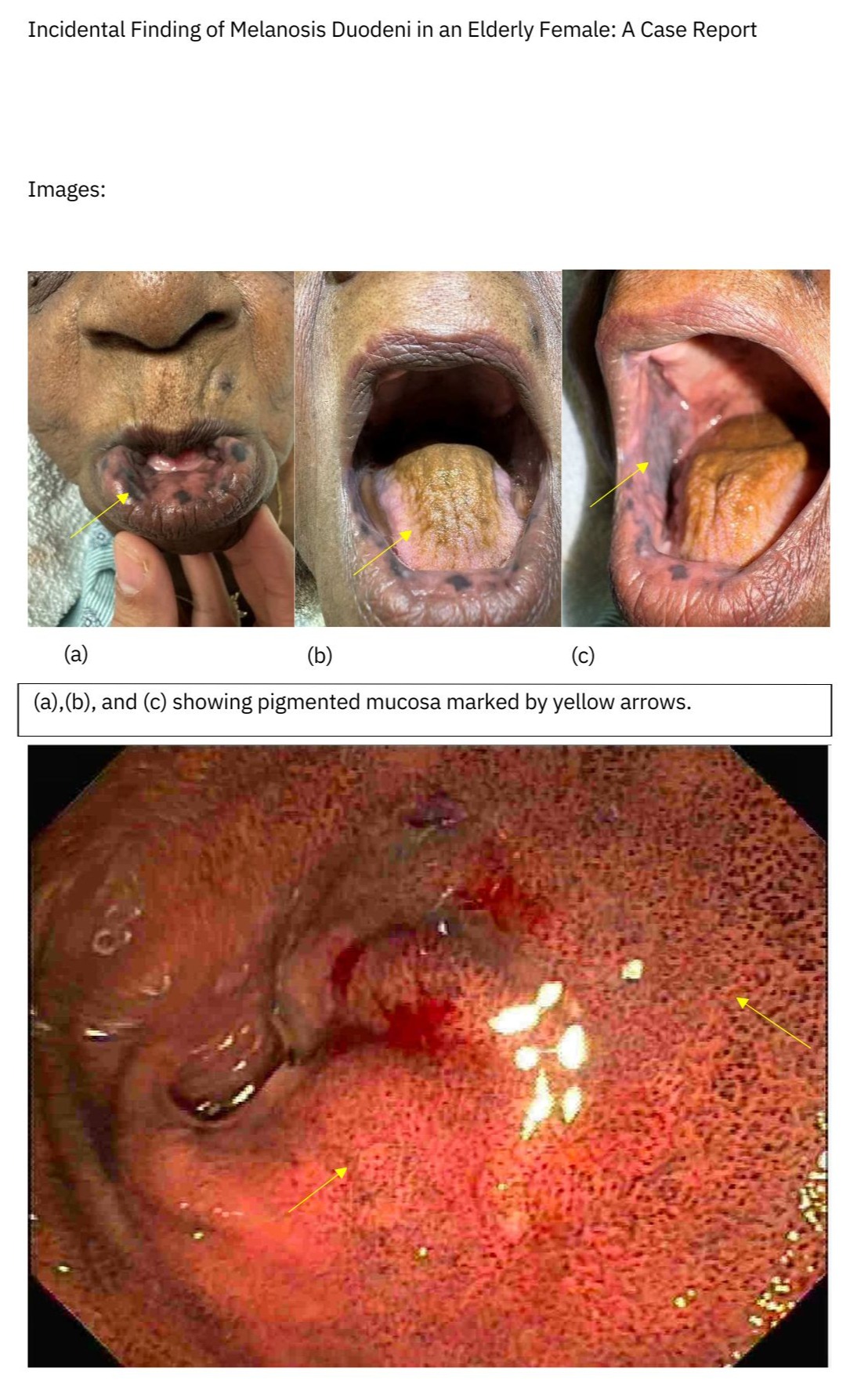Tuesday Poster Session
Category: Small Intestine
P5001 - Pseudomelanosis Duodeni: An Unusual Endoscopic finding
Tuesday, October 29, 2024
10:30 AM - 4:00 PM ET
Location: Exhibit Hall E

Has Audio

Ibukunoluwa E. Oshobu, MD
University of Missouri Health Care
Columbia, MO
Presenting Author(s)
Ibukunoluwa Oshobu, MD1, Sanket Basida, MD2, Muhammad Nadeem. Yousaf, MD1, Farah Heis, MD1, Deepthi Rao, MD, MS2, Ghassan Hammoud, MD1
1University of Missouri Health Care, Columbia, MO; 2University of Missouri School of Medicine, Columbia, MO
Introduction: Pseduomelanosis duodeni is a rare condition characterized by the accumulation of macrophage laden melanin like pigment in the duodenal mucosa. Iron supplementation, bismuth-containing medications, certain antibiotics such as minocycline, sulfur-containing diuretics, chronic conditions like Celiac disease, Chronic Kidney Disease, and neoplasms such as Melanoma are some of the causes of pigmented duodenal mucosa. It is often detected incidentally during endoscopic procedures and can mimic more sinister pathologies such as neoplastic lesions.
Case Description/Methods: We report a case of an 89-year-old female who presented to the emergency department with right lower quadrant abdominal pain. Her vitals at the time of presentation were within normal limits. Blood work-up was remarkable for elevated creatinine 1.4 (baseline), Alkaline phosphatase 120. Computed tomography of the abdomen and pelvis revealed incidental common bile duct (CBD) dilation up to 1 cm, raising concerns for an ampullary mass or stricture. Subsequent outpatient esophagogastroduodenoscopy (EGD) with endoscopic ultrasound (EUS) was performed, revealing pigmented duodenal mucosa without evidence of CBD lesions. Biopsies obtained during the procedure confirmed the diagnosis of pseudomelanosis duodeni.
Discussion: Pseudomelanosis duodeni is often benign and asymptomatic, though it can pose diagnostic challenges due to its resemblance to more severe conditions, including melanoma. In our case, thorough endoscopic evaluation, including EGD with EUS, allowed for accurate diagnosis and exclusion of other pathologies. Given the benign nature of melanosis duodeni, conservative management was pursued. The current literature on Pseduomelanosis duodeni suggests iron supplementation is a possible risk factor for this benign finding, along with a proposed pathophysiology of iron coupling with sulfur. However, the causal relationship is not established. Our patient had been on Iron supplementation at the time of diagnosis, which could explain this finding. This case highlights the importance of considering pseudomelanosis duodeni in the differential diagnosis of the incidental conclusions of mucosal pigmentation. Endoscopic evaluation with biopsy remains crucial for accurate diagnosis and appropriate management, particularly in elderly female patients presenting with abdominal symptoms.

Disclosures:
Ibukunoluwa Oshobu, MD1, Sanket Basida, MD2, Muhammad Nadeem. Yousaf, MD1, Farah Heis, MD1, Deepthi Rao, MD, MS2, Ghassan Hammoud, MD1. P5001 - Pseudomelanosis Duodeni: An Unusual Endoscopic finding, ACG 2024 Annual Scientific Meeting Abstracts. Philadelphia, PA: American College of Gastroenterology.
1University of Missouri Health Care, Columbia, MO; 2University of Missouri School of Medicine, Columbia, MO
Introduction: Pseduomelanosis duodeni is a rare condition characterized by the accumulation of macrophage laden melanin like pigment in the duodenal mucosa. Iron supplementation, bismuth-containing medications, certain antibiotics such as minocycline, sulfur-containing diuretics, chronic conditions like Celiac disease, Chronic Kidney Disease, and neoplasms such as Melanoma are some of the causes of pigmented duodenal mucosa. It is often detected incidentally during endoscopic procedures and can mimic more sinister pathologies such as neoplastic lesions.
Case Description/Methods: We report a case of an 89-year-old female who presented to the emergency department with right lower quadrant abdominal pain. Her vitals at the time of presentation were within normal limits. Blood work-up was remarkable for elevated creatinine 1.4 (baseline), Alkaline phosphatase 120. Computed tomography of the abdomen and pelvis revealed incidental common bile duct (CBD) dilation up to 1 cm, raising concerns for an ampullary mass or stricture. Subsequent outpatient esophagogastroduodenoscopy (EGD) with endoscopic ultrasound (EUS) was performed, revealing pigmented duodenal mucosa without evidence of CBD lesions. Biopsies obtained during the procedure confirmed the diagnosis of pseudomelanosis duodeni.
Discussion: Pseudomelanosis duodeni is often benign and asymptomatic, though it can pose diagnostic challenges due to its resemblance to more severe conditions, including melanoma. In our case, thorough endoscopic evaluation, including EGD with EUS, allowed for accurate diagnosis and exclusion of other pathologies. Given the benign nature of melanosis duodeni, conservative management was pursued. The current literature on Pseduomelanosis duodeni suggests iron supplementation is a possible risk factor for this benign finding, along with a proposed pathophysiology of iron coupling with sulfur. However, the causal relationship is not established. Our patient had been on Iron supplementation at the time of diagnosis, which could explain this finding. This case highlights the importance of considering pseudomelanosis duodeni in the differential diagnosis of the incidental conclusions of mucosal pigmentation. Endoscopic evaluation with biopsy remains crucial for accurate diagnosis and appropriate management, particularly in elderly female patients presenting with abdominal symptoms.

Figure: Pseudomelanosis
Disclosures:
Ibukunoluwa Oshobu indicated no relevant financial relationships.
Sanket Basida indicated no relevant financial relationships.
Muhammad Yousaf indicated no relevant financial relationships.
Farah Heis indicated no relevant financial relationships.
Deepthi Rao indicated no relevant financial relationships.
Ghassan Hammoud indicated no relevant financial relationships.
Ibukunoluwa Oshobu, MD1, Sanket Basida, MD2, Muhammad Nadeem. Yousaf, MD1, Farah Heis, MD1, Deepthi Rao, MD, MS2, Ghassan Hammoud, MD1. P5001 - Pseudomelanosis Duodeni: An Unusual Endoscopic finding, ACG 2024 Annual Scientific Meeting Abstracts. Philadelphia, PA: American College of Gastroenterology.
